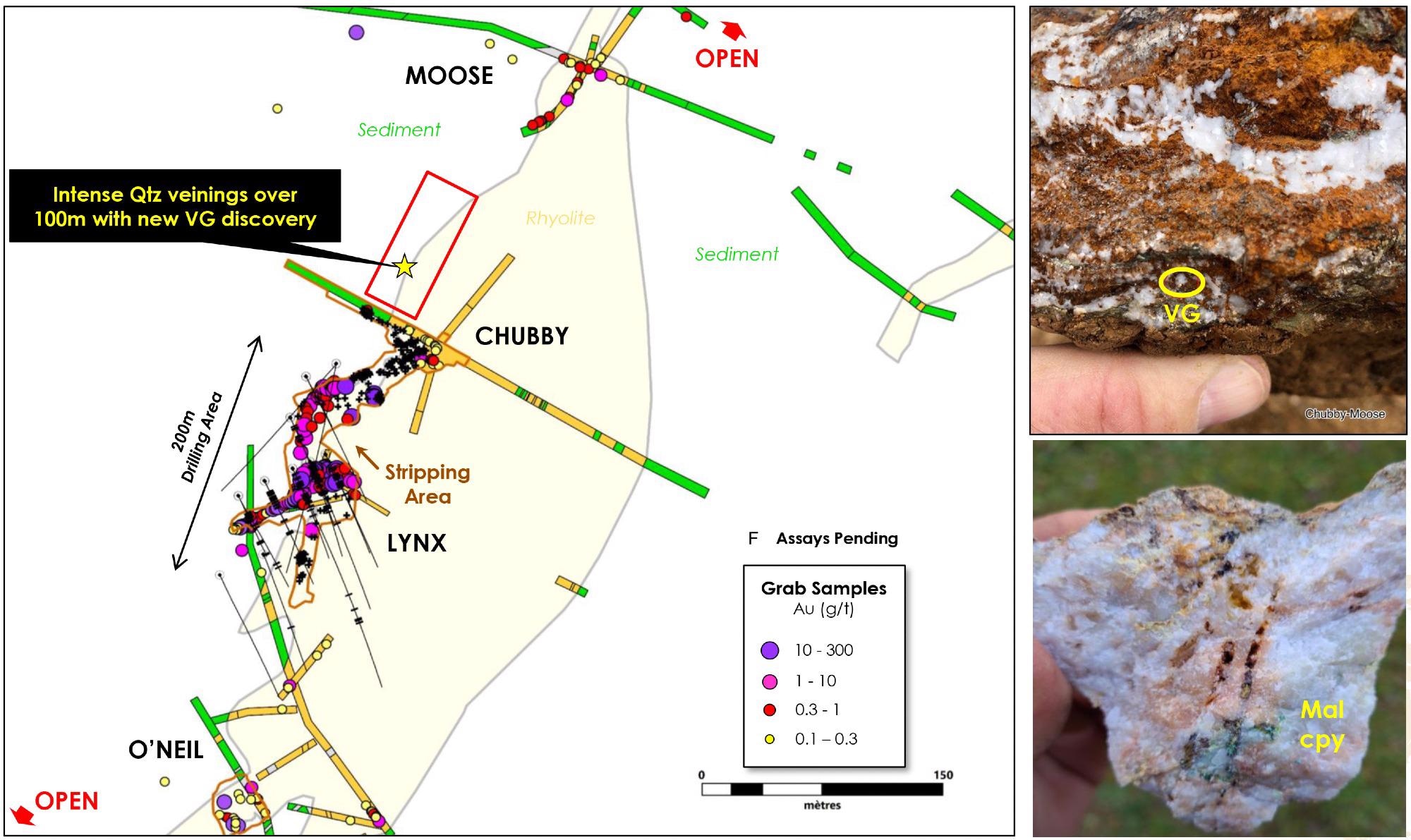Thanks to surface trenching and stripping programs at its Williams Brook Gold Project situated in New Brunswick, an evolving new gold district of Atlantic, Canada, Puma Exploration reports the discovery of a new 100 m-long high-density quartz veining zone with visible gold (VG).
 O’Neil Gold Trend New Discovery Map. (Image Credit: Puma Exploration Inc.).
O’Neil Gold Trend New Discovery Map. (Image Credit: Puma Exploration Inc.).
A large zone of quartz veins and veinlets has been discovered by the ongoing program of trenching and stripping along the O’Neil Gold Trend (OGT). The new zone is situated 150 m NE of Lynx. It can be pursued for over 100 m, thus far, on surface, between the Chubby and Moose Gold Zones. VG has been recognized in a quartz/iron oxides vein.
This new manifestation of various gold-bearing quartz veins corresponds with an abrupt change in the direction of the rhyolite/sediment contact as estimated by the Company’s structural model. As other comparable flexures of the lithological contact are anticipated, trenching and stripping will carry on moving NE along the OGT with two excavators, one bulldozer and two trucks, subject to weather conditions.
The discovery of this new significant high-density quartz veining zone containing visible gold confirms that the exploration model of our technical team works perfectly. Actual stripping is widening this new gold-bearing quartz zone in preparation for intense sampling. The size, the abundance of quartz, the alteration, and the visible gold makes this new occurrence a premium drill target!
Marcel Robillard, President and CEO, Puma Exploration
These gold-bearing quartz veins networks are constant along the promising contact sediment/rhyolite, and the latest sampling results verified the existence of other comparable systems along strike within the 7 km potential OGT. Stripping and intense sampling will then be stretched an extra 300 m NE in the direction of the Moose Gold Zone and beyond.
O’Neil Gold Trend (OGT)
The OGT is a pervasive altered and brecciated rhyolite unit holding major gold showings and occurrences trailed by trenching and drilling across a strike length of 700 m.
The geophysical signature of the OGT is seen across 7 km. The promising unit (rhyolite) is similar and parallel to the structures hosting the “Williams 1” and “Williams 2” Gold Zones where, in 2008, a former operator drilled grades of 54.2 g/t Au over 2.8 m and 1 g/t Au over 23 m.
These trends are inferred to be connected with a significant rifting in the New Brunswick geological events and could signify a low sulfidation epithermal gold system. Along the OGT, the width of the rhyolite differs from 5 to 250 m with an average visible thickness of 150 m.
The core-aligned maiden drill campaign was finished on August 20, 2021. It comprised 18 holes for a maximum of 2,360 m that tested a 200-m segment of the 700-m-long OGT.
The results of the assay for the 12 first holes are available, and all holes intersected substantial gold mineralization, including the discovery hole WB21-02 that cut 5.55 g/t Au over 50.15 m from surface, including 9.88 g/t Au over 8.60 m and 46.94 g/t Au over 3.85 m. The assays are awaiting the other 6 drill holes.
High-Grade Selected Grab Samples Assays on the Prolific OGT*:
- O’Neil Gold Zone: 128.5 g/t Au, 44.4 g/t Au, 38.8 g/t Au, 32.8 g/t Au, 23.1 g/t Au
- Lynx Gold Zone: 241.0 g/t Au, 79.8 g/t Au, 74.2 g/t Au, 63.5 g/t Au, 58.4 g/t Au
- Pepitos Gold Zone: 52.1 g/t Au, 16.1 g/t Au, 15.0 g/t Au, 13.1 g/t Au, 4.87 g/t Au
- Moose Gold Zone: 2.4 g/t Au, 2.1 g/t Au, 1.3 g/t Au, 1.1 g/t Au
- Chubby Zone Area: 3.5 g/t Au, 1.2 g/t Au, 1.2 g/t Au, 0.45 g/t Au
* Selected rock grab samples are selective by nature and may not represent the true grade or style
Qualified Persons
Dominique Gagné, PGeo, an independent qualified person as stipulated by Canadian National Instrument 43-101 standards, has appraised and permitted the geological data reported in this article.
Mr. Gagné is autonomous of Puma Exploration.
Quality Assurance/Quality Control (QA/QC)
Rock samples were bagged, sealed and transported to the facility of ALS CHEMEX in Moncton, New Brunswick where all the samples were dried, crushed and made into pulp form. The samples were crushed to 70% measuring less than 2 mm, riffle split off 1 kg, pulverize split to better than 85% passing 75 µm (Prep-31B).
A 30-g subsplit from the ensuing pulp was then exposed to a fire assay (Au-ICP21). Other screen sizes are present. Identical 50 g assay on screen undersize. Assay of the whole oversize fraction.